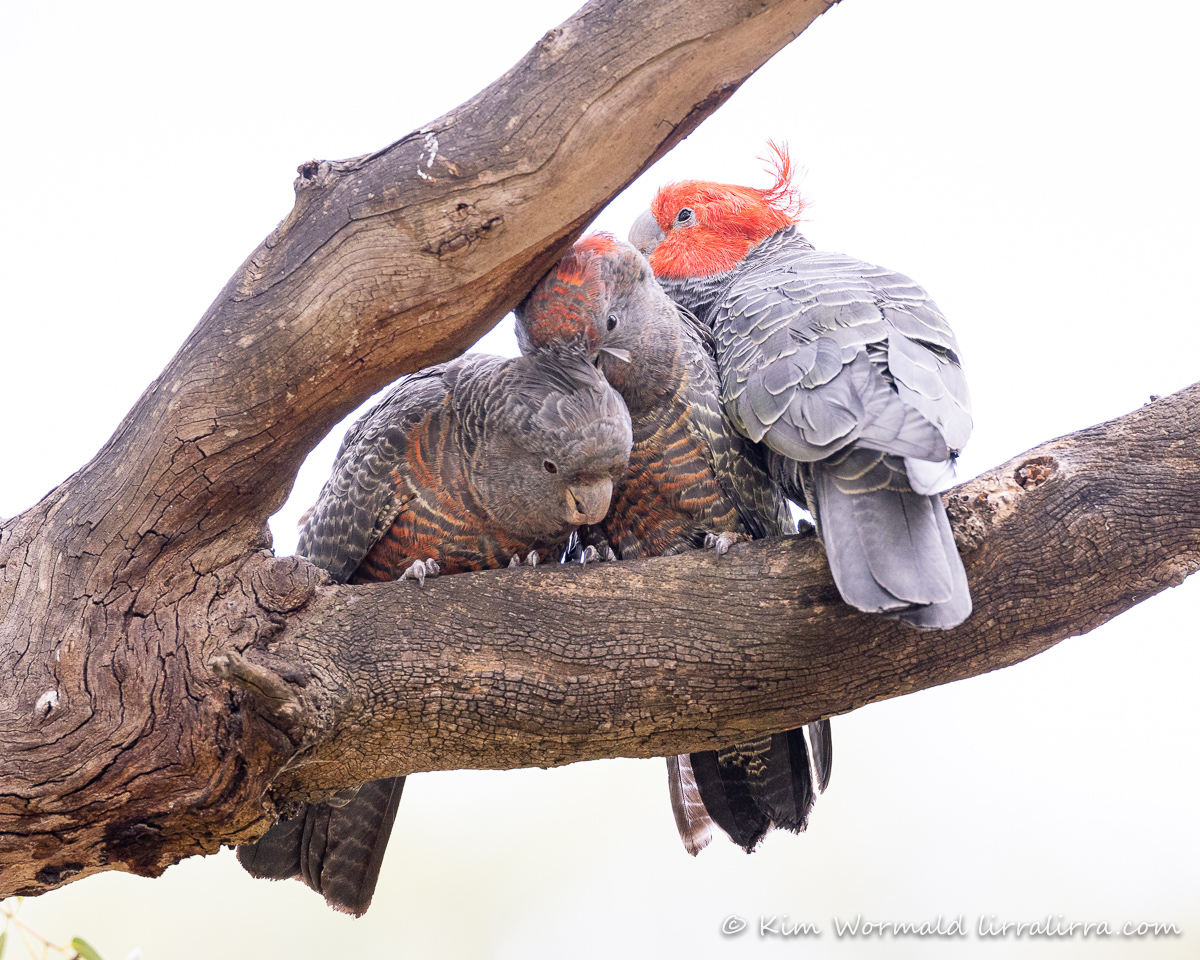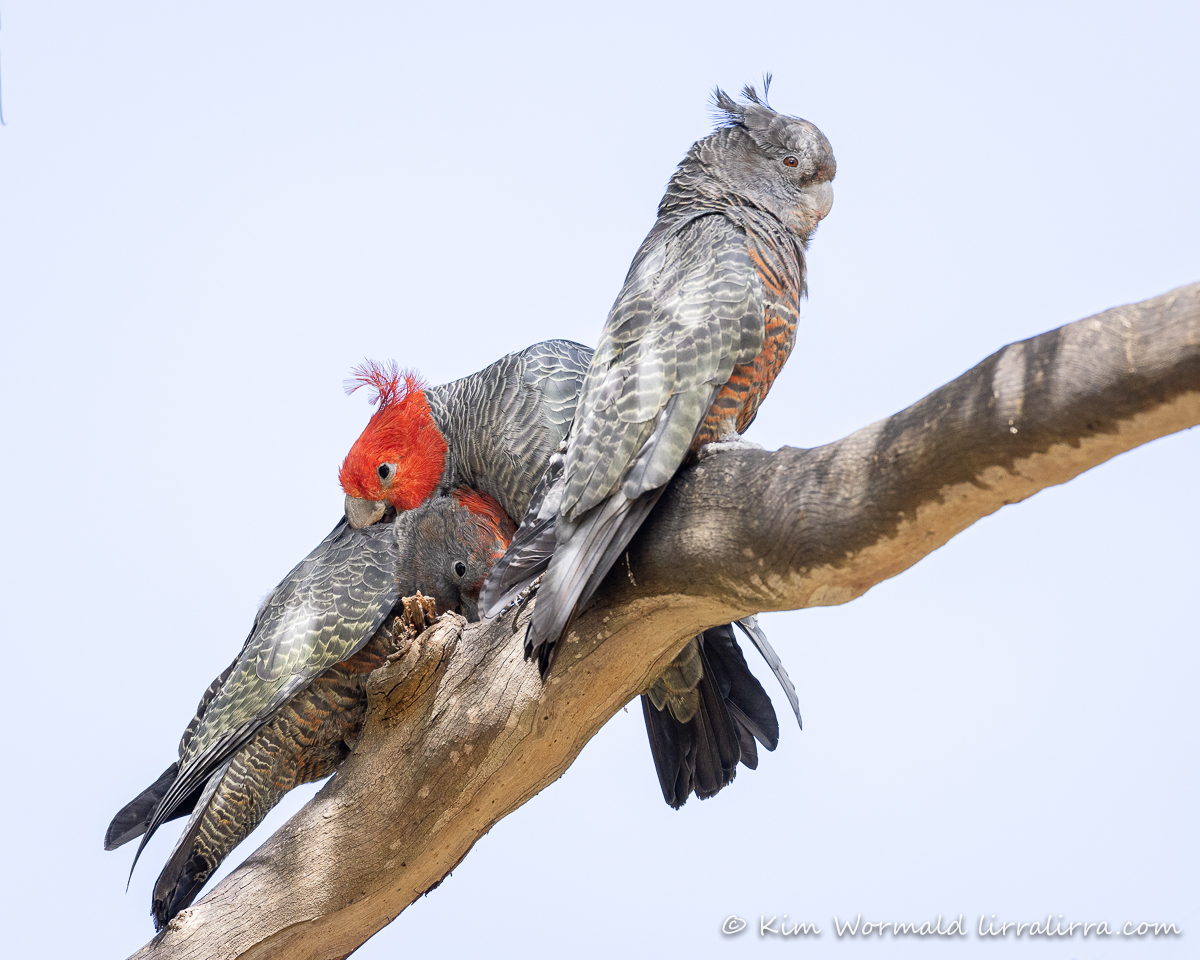It was pure joy to watch this Gang-gang Cockatoo family allopreening each other.

1/800, f/5.0, ISO 1600
Canon R5, Canon 600 f/4 L IS USM
I’ve been thinking a lot about families this week so am sharing this exquisite family of snuggling Gang-gang Cockatoos. The juvenile male is starting to grow his wispy red head feathers, and is snuggled between his parents. It was super cute to watch them preening each other, allopreening, and I was rapt to capture this shot of the juvenile preening his mother’s feathers – it’s the avian equivalent of a toddler hugging its mother while the father keeps watch.

1/800, f/5.0, ISO 1600
Canon R5, Canon 600 f/4 L IS USM
Allopreening occurs with many species and is a form of social grooming that helps develop and maintain bonding. It is quite beautiful to watch. In the second photograph the gang-gangs had moved into the dappled light on another branch; the adult male is preening the juvenile male.
Happy birding, Kim
~ Prints and gifts Lirralirra Shop
~ Facebook page Kim Wormald – lirralirra
~ Facebook group Ethical Bird Photography

Hi Kim,
I have been photographing a group of 15 over the last few weeks but I have not seen any allopreening. Thanks for these incredible photos Kim and for explaining the concept. There are several juveniles in the group and it has been wonderful to watch them being fed and observe their interactions with their parents and siblings. They are such rare and precious birds and you have captured them beautifully. Thanks again for your beautiful wildlife photos. Xx
Oh how exciting Giovanna! Gang-gangs are so beautiful to watch, and I’d love to be beside you as you watch the group you mention. Thanks for your kind comment, it is much appreciated, Kim x
Wow! Beautiful photos, Kim.
It was so magical Liz, especially lovely when they called to add to the bliss.
Beautiful Kim…
Thanks heaps Ron
They are the emblematic bird of my city and I virtually never see them – I hear their swinging rusty gate call, but rarely see them. I would be over the moon to see this. Thank you, thank you, thank you.
Oh EC I do hope you see them soon. I love their call, and as I mentioned it’s often the first inkling I have that they are around. They’re often pretty still as they feed, spending quite a time in the same place, which makes them even harder to spot.
That’s really fascinating to learn that about disruptive camouflage, Kim. I had no idea about this – I’ve often thought the same about Rainbow Lorikeets – because we see them here in Melbourne’s suburbs, and they are so vibrant and easy to spot – although probably not in a bushland setting against the foliage, instead of urban telephone poles.
Your artistic eye enriches all our lives – because you joyfully remind us of the beauty of birds.
It’s fascinating isn’t it. Even with Rainbows and Crimsons, how they fly into the treetops and disappear. ‘Urban telephone poles’ made me chuckle! Thanks heaps for your kind words, Kim
What a magical moment! That dusty grey with the splash of vibrant red makes my heart sing – just goes to show, Nature never gets the colours wrong.
I can see from an evolutionary point of view, that the grey feathers help camouflage the birds against the grey gum branch – but the dazzling red makes them very conspicuous to predators. So, it seems to me, that Nature just can’t resist the frivolous and flamboyant urge to decorate birds -the birds, of course, have no idea that they are so beautiful – lucky us, who can gaze and gasp in rapture!
I love your descriptions Deirdre, they’re so poetical (which the gang-gangs definitely deserve!). About the bright colours, though I’m sure they are there to decorate the birds, they are also quite ridiculously good camouflage. I did a post ages ago that I called Colourful Camouflage (from memory) which explains how disruptive camouflage works. There are often a surprising number of richly coloured red leaves in eucalyptus trees, and the berries that these gang-gangs were eating were also red. When they were amongst the berries or foliage I often heard them before I saw them. Gazing and gasping was definitely on my agenda!